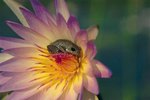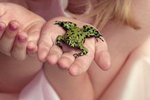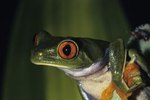Counter shading is a type of camouflage used by frogs, salamanders and turtles. Species that have counter shading have lighter colors on their stomachs and darker colors on their backs. This difference in color on a frog's body helps him hide from predators on land, birds in the air, and fish and other aquatic predators.
Skin Pigmentation
The color or pigmentation of a frog's skin can allow him to hide by blending in with surrounding colors in the environment. Many types of frogs can make their skin color brighter, but they cannot change into a different color, as some lizards can. This change occurs gradually and is often used to regulate body temperature during sunny, hot seasons. Frogs come in a variety of colors, from bright red and brilliant jade green to mottled brown. They can be black and white, and even have several different marbled shades of brown on their skin. Some frogs use bright colors to warn predators that they are poisonous, or to mimic other types of poisonous frogs that are the same color.
About Camouflage
Camouflage is a type of animal defense mechanism. By having skin colors that match the environment, it allows a frog to conceal himself in plain sight. It is an adaptation that relies on a form of visual deception that allows a frog to hide from potential predators and to also hide from prey. Many frogs will sit still and wait for insects or other prey to pass by and catch them with their sticky tongues. Frogs do not typically go out and hunt for food, but wait for it to come to them and rely on camouflage to remain undetected. This increases the frog's chances of catching food.
Counter Shading
Counter shading is a type of camouflage called crypsis, which is an animal's ability to avoid being seen by other animals. Counter shaded animals have a lighter color on the bottom of their bodies and a darker color on the top. The lighter colored underside protects them from animals that live in water. When looking up for potential prey, the light color blends in with the sunlight that is filtering down through the water, and the frog is not noticed by the predator.
Top Shading
Depending on where the frog lives, counter shaded frogs can have a top color that is bright green, faded brown or gray. Bright green-topped frogs live in areas where there is a lot of foliage, such as a rain forest, where birds and other animals that live in the trees will not see them, because they blend in with their surroundings. Frogs that live in murky waters or around areas covered by dead leaves will have a faded brown or grey top color that allows them to hide on the forest floor.
References
Photo Credits
-
frog on a hand - black-eyed tree frog sitting on a hand image by Christophe Fouquin from Fotolia.com
Writer Bio
Alexis Rohlin is a professional writer for various websites. She has produced works for Red Anvil Publishing and was one of the top 10 finalists in the 2007 Midnight Hour Short Story Contest for OnceWritten.com. Rohlin holds a Bachelor of Fine Arts in English from Madonna University.





